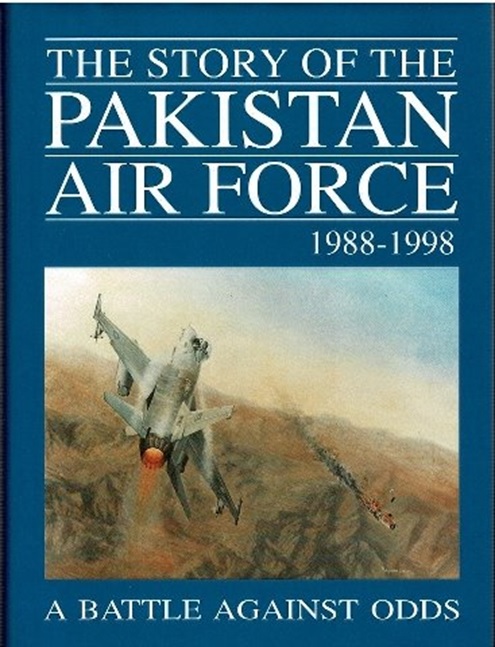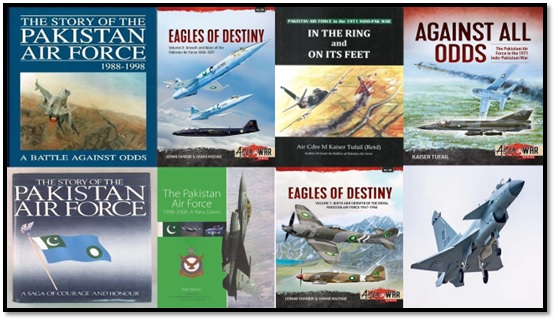Book & Author
M. J. Gohari: The Story of The Pakistan Air Force 1988-1998 — A Battle Against Odds
By Dr Ahmed S. Khan

“A country without a strong Air Force is at the mercy of any aggressor. Pakistan must build up her Air Force as quickly as possible. It must be an efficient Air Force, second to none.” — Quaid-i-Azam Muhammad Ali Jinnah, Address to RPAF Training School, Risalpur, April 13, 1948
Indeed, the vision of Quaid-i-Azam has been transformed into reality. During the past seven decades Pakistan Air Force (PAF) has emerged as one of the strongest Air Forces of the world due to the dynamic and visionary leadership of Air Marshal Asghar Khan and Air Marshal Nur Khan. They laid the foundations of a very efficient, professional Air Force which can deter any aggression against the nation.
The recent Pakistan-India Air force skirmish was of an epic proportion — it was the largest air battle since World War II that took place during the night of May 6 to early hours of May 7 in skies over Kashmir and Punjab — over 125 jet fighters (42 Pakistani and 70+ Indian) clashed without crossing over international borders. Pakistan Air Force (PAF) —using state of the art technology and highly skilled and professional pilots shot down six Indian fighters: three Rafales, one SU-30, one MIG-29 and one Mirage-2000 — and in the process debunked the myth of Indian air superiority via French and Russian technologies, and emerged as an efficient Air Force, second to none, as envisioned by the Quaid-i-Azam.
The Pakistan-India air skirmish was also a game changing event — no visual interaction between the fighters of two countries took place — for the first time in history, all combat action took place in the Beyond Visual Range (BVR) domain. Pakistan Air Force established its complete supremacy in the skies over South Asia and in the process sent a strong message to Modi’s India not to mess with Pakistan, and also provided a narrow window of opportunity for Pakistan’s military leadership to rectify its blunders by establishing rule of law, freeing Imran Khan and making Pakistan a democratic country as envisioned by Quaid-i-Azam, the father of the nation.
After the ceasefire brokered by President Trump went into effect, Chengdu's (manufacturer of J-10C) stock price increased by forty percent whereas the stock of Dassault Aviation (maker of Rafale) plummeted by ten percent. PAF’s superior performance has opened an avenue for smaller nations to opt for J-10C ($40 million) versus Rafale ($300 Million).
Air Marshal M. Asghar Khan (January 17, 1921 – January 5, 2018) and Air Marshal Nur Khan (February 22, 1923 – December 15, 2011) are regarded as the founders of contemporary Pakistan Air Force. AM Asghar Khan commanded the Pakistan Air Force (1957-1965) and was its first Pakistani Commander-in-Chief at the age of thirty-six. He also served as President of Pakistan International Airlines (PIA: 1965-1968). AM Nur Khan served as the sixth commander-in-chief of the Pakistan Air Force (1965-1969). He also served as the managing director of PIA (1959-1965). During their tenures at PAF and PIA —AM Asghar Khan and AM Nur Khan—by their dynamic leadership transformed both organizations into highly efficient world-class entities.
Pakistan Air Force has produced numerous ace pilots. One such pilot was Air Commodore M. M. Alam (July 6, 1935 – March 18, 2013). After the September 1965 War, M. M. Alam emerged as Pakistan’s top scoring fighter ace. Squadron Leader Muhammad Mahmud Alam flying his favorite F-86 F-35-NA shot down nine Indian air fighters in air-to-air combat and was also credited for two probable kills. He was the Commander of the No 11 squadron. On September 7, 1965, in the skies above Sargodha, Squadron Leader M. M. Alam downed five Indian aircraft in less than sixty seconds and thus established a world record. He was awarded Sitara-e-Jurat for this unique feat.
Discussing the psyche of ace PAF pilots, Indian author Diptendu Choudhry observes: “Since it is the man behind the machine who drives the ultimate outcome in war, the mindset and psyche of the PAF pilot need a mention. In a country where the military is held in high esteem and is considered a prestigious career, the PAF fighter pilot is perhaps the most privileged person—well paid, highly regarded and the subject of national adoration…PAF pilots have flown in Algeria, Egypt, Iraq, Jordan, Kuwait, Libya, Qatar, Saudi Arabia, Sri Lanka, Syria, Turkey, UAE, UK, and Zimbabwe. Its pilots gained extensive experience on a wide range of fighters including the Gnat, Hunter, MiG-21FL/M, and Su-7…’ Firsthand knowledge about adversary aircraft, as well as well-honed flying skills of PAF’s pilots were key factors in their remarkable performance during various conflicts.’”(Operational Approach and Psyche of Pakistan Air Force, Defense and Diplomacy, Vol II No 1, Oct-Dec 2021)
Choudhry further observes: “The PAF maintains skill-based posting to fighter types and younger age profile Squadron Commanders. In the words of Asghar Khan, who had been the C-in-C for eight years: After Station Commanders, or perhaps even more important than them, is the selection of Squadron Commanders. They are the people who command the combat units of the Air Force. Their number in a small Air Force is necessarily small and their importance, therefore, all the greater. It is my belief that these few commanders must be above average in their own spheres. I was prepared to overlook some human failings so long as they commanded respect in the air. They must be professionally sound and superior to those they are required to lead. No other quality, however great, can compensate for these essential requirements in the eyes of subordinates.’”
PAF has always incorporated the state-of-the-art aircraft in its squadrons. Discussing the induction of American planes in the PAF, Usman Shabbir and Yawar Mazhar observe: “In the 1950s Pakistan aligned itself with the United States of America under the newly formed SEATO (South East Asian Treaty Organization) and the later British sponsored CENTO (Central Treaty Organization) security pacts formed to contain the former Soviet Union. As part of these pacts Pakistan was recipient of a Mutual Assistance Program (MAP) which formed the basis of Pakistan Air Force (PAF) being reorganized on modern lines based on the model of United States Air Force (USAF). Over the late 1950s and till the middle of the 1960s, PAF was equipped with American aircraft like the F-86 Sabre, T-33, T-37s, C-130s and B-57s. Under this arrangement Pakistan also allowed United States basing rights for U-2 reconnaissance aircraft missions. In May 1960 it was during one of these missions that a U-2 aircraft piloted by Gary Powers was shot down over the Soviet Union. It was after this incident and subsequent Soviet threats to Pakistan that the US agreed to provide Pakistan with higher performance fighter aircraft. The choice settled on F-104As after PAF‟s refusal to accept an American offer for F-100 Super Sabre aircraft” (F-104 Starfighter in Pakistan Air Force Service, 2009, Eagles of Destiny, available on the Internet).
A number of books have been published highlighting the history, accomplishments and leaders of the Pakistan Air Force. Some of the notable titles include: Battle For Pakistan: Eagles of Destiny (Volume I): Birth and Growth of the Royal Pakistan Air Force 1947-1956, The Story of Pakistan: A Saga of Courage and Honor, Flight of the Falcon: Demolishing Myths of Indo Pak Wars 1965-1971, Air Warriors, Great Battles of Pakistan Air Force , The Air War of 1965, Against All Odds: The Pakistan Air Force in the 1971 Indo-Pakistan War, The Story of Pakistan Air Force 1988-1998 — A Battle Against Odds, and many others.
The Story of Pakistan Air Force 1988-1998 — A Battle Against Odds by M. J. Gohari chronicles the operational and strategic development of PAF during a transformative decade — a period of significant challenges. The book is an extension of “The Story of Pakistan: A Saga of Courage and Honor” that covers the early history of PAF for the period 1947-1987. The author has done an excellent job of chronicling the details of progression in PAF for the period 1988-1998 when Pakistan faced US military sanctions — jeopardizing the maintenance of F-16 fighters via supply of missiles, parts, and radars. The PAF leadership came up with innovative indigenous solutions to keep the F-16s operational. The book provides details of revised procurement, maintenance, and operational processes and procedures of diversification of suppliers and use of indigenous sources.
The book also covers key combat challenges faced by the PAF during the Soviet occupation of Afghanistan — how to deal with superior Soviet planes of the Afghan air force. The book contains narrations by pilots who had combat engagements with the Soviet planes of the Afghan air force, and provides details of pilot training programs, various squadrons and bases, and exercises conducted to maintain operational preparedness.
The book has several notable strengths — 1. Excellent Research: The book benefits from its use of primary sources, archival records, and firsthand accounts. The detailed research not only lends originality to narration but also offers readers insights into operational challenges and strategic decisions of the PAF during a turbulent decade. The originality of the narrative coupled with detailed documentation — from personal accounts to official records — brings credibility to the narrative. 2. Comprehensive Analysis: In addition to describing military events, the book excels at situating the PAF’s operations within a broader geopolitical framework. It explores how external factors — like the Afghan war and Pressler sanctions shaped the evolution of PAF’s air power strategies and policies. 3. Balanced Narrative and Scholarly Rigor: The material is presented using a balanced narrative and in a scholarly manner. This approach makes the work accessible to both history students and military experts, and 4. Visual and Illustrative Component: Complementing its excellent in-depth narrative, the book is enriched with a plethora of illustrations, photos and diagrams that help readers to visualize complex military details and strategies.
Despite these advantages, the book has some limitations — 1. Dense Technical Jargon: while the book offers an excellent narrative on air power strategies and operations, its heavy reliance on technical jargon can be overwhelming for a general reader. 2. Narrow focus on Impact of Strategies: the book heavily concentrates on events, strategies and operational challenges faced by the PAF during 1988-1998 but lacks a broader contextual framework — the impact of PAF’s policies and strategies on regional and global levels, and 3. Institutional Perspective and lack of global views: the narrative offers the official views of PAF and lacks global perspectives. While The Story of Pakistan Air Force 1988-1998 — A Battle Against Odds is a valuable resource for its detailed historical account and technical precision, these limitations are important to consider depending on the reader’s preferences and background. For a more holistic understanding, it might be worthwhile complementing this reading with other works that address broader geopolitical implications, personal narratives, or post-decade analyses of the PAF’s evolution during the period of 1988-1998.
The Story of Pakistan Air Force 1988-1998 — A Battle Against Odds by M. J. Gohari is an important historical work. It is not only a vital document of military history but also a strong narrative on the evolution of air power during one of the most challenging periods in the history of the region. It presents an interplay between military strategy, technological innovation, and geopolitical dynamics.
The book provides an in-depth narrative on how the Pakistan Air Force navigated significant challenges by adapting its strategies and operations during one of the most challenging periods. The way the PAF evolved — in the face of internal and external pressures — is captured with nuance, highlighting themes of resilience, leadership, and innovation. It is essential reading for all. Readers can gain a profound understanding of how institutions can adapt and thrive even under adverse conditions.
(Dr Ahmed S. Khan is a Fulbright Specialist Scholar)


